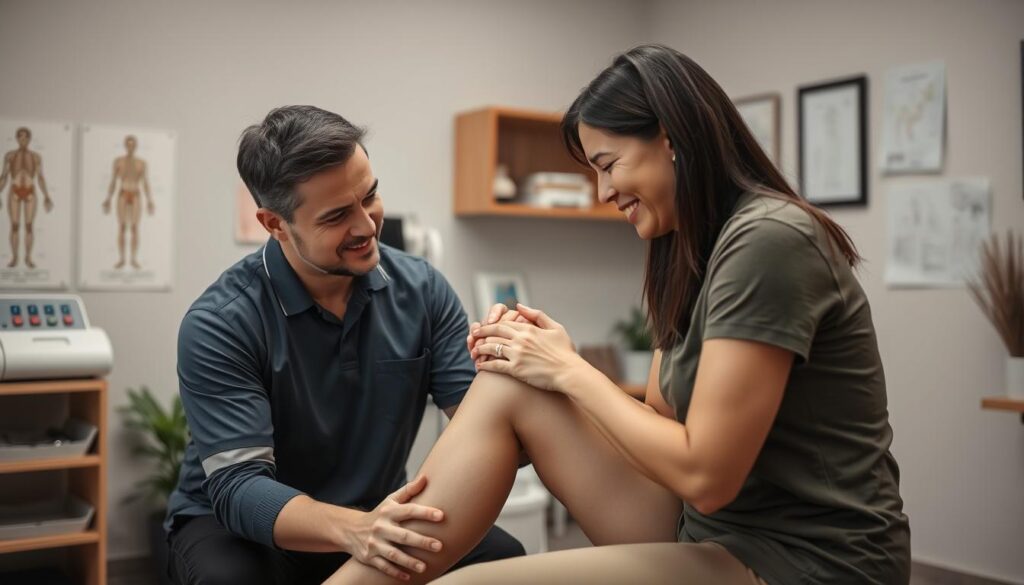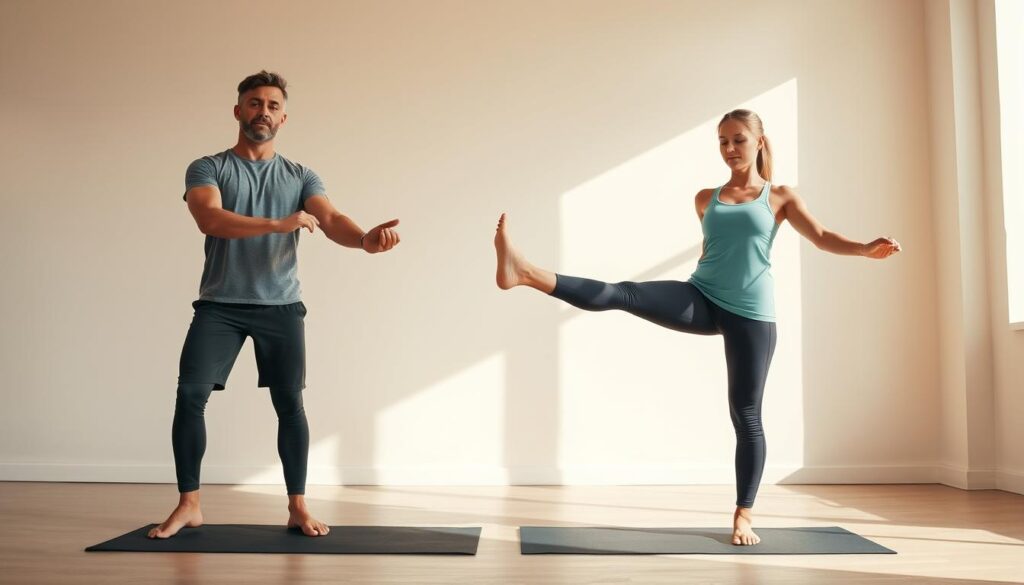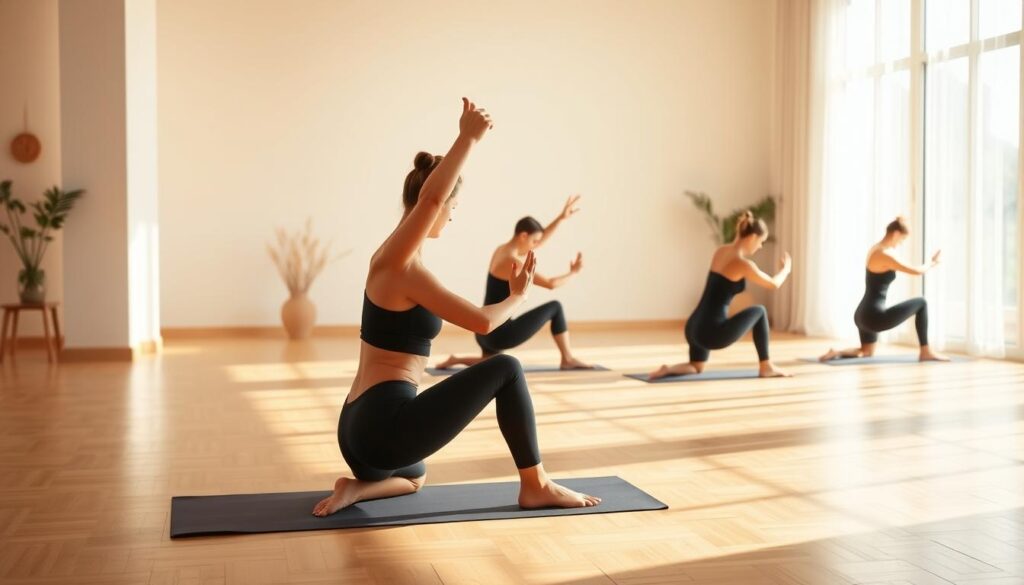What if the secret to lasting knee health isn’t about pushing harder—but cushioning smarter? For athletes, fitness enthusiasts, and anyone battling joint discomfort, targeted movements on forgiving surfaces can unlock surprising benefits. We’ll explore how this approach reduces strain while building strength where it matters most.
Gentle routines on padded floors or mats protect joints better than hard surfaces. Focused exercises strengthen the hips, thighs, and calves—key areas supporting knee stability. Whether you’re recovering from injury or preventing one, these low-impact techniques adapt to all fitness levels.
Starting with basic stretches like calf raises and leg lifts builds foundational strength. Over time, this prepares your body for squats and dynamic motions without overwhelming delicate joints. The result? Improved flexibility, reduced pain, and confidence in every movement.
Key Takeaways
- Soft surfaces minimize joint pressure during kneeling exercises
- Targeted movements strengthen hip and leg muscles for better knee support
- Beginner-friendly stretches reduce injury risk while improving flexibility
- Progress gradually from basic stretches to advanced strength-building moves
- Ideal for athletes, active individuals, and those managing joint discomfort
Understanding the Importance of Proper Stretching
Movement serves as medicine for joints when approached strategically. Targeted routines prepare your body to handle daily stresses while protecting vulnerable areas. This foundation becomes especially crucial for maintaining knee health and preventing long-term mobility limitations.

Benefits for Knee Health and Mobility
Consistent stretching boosts blood flow to leg muscles and connective tissues. This delivers essential nutrients while flushing out inflammation-causing waste products. Improved circulation reduces morning stiffness and helps joints move smoothly.
Gentle stretching exercises maintain the knee’s natural range of motion, counteracting the tightening effects of aging. They also stimulate synovial fluid production – your joint’s natural lubricant. For those managing arthritis or past injuries, controlled movement prevents scar tissue buildup.
How Soft Surfaces Enhance Exercise Safety
Cushioned flooring absorbs up to 30% more impact than hard surfaces during movements. A quality mat distributes weight evenly across knees and hips, reducing pressure points. This support allows deeper stretches without compromising joint integrity.
Padded surfaces enable proper alignment during hip-focused exercises. They let muscles engage fully rather than tensing against discomfort. For rehabilitation cases, this cushioning provides psychological reassurance to move through safe ranges.
Remember: Effective recovery begins with respecting your body’s signals. Gradual progression on forgiving surfaces builds confidence alongside physical resilience.
Getting Started: Setting Up Your Soft Surface Routine
Creating a foundation for effective movement begins with intentional preparation. Your exercise environment directly impacts joint safety and exercise quality—especially when working on padded surfaces.

Preparing Your Mat and Space
Choose a mat with ¼-½ inch thickness for balanced cushioning and stability. Dense foam or rubber materials provide better hip and knee support than thin yoga mats. Clear a 6×6 foot area to allow full leg extensions and lateral movements.
Check flooring surfaces for hidden objects that could shift during exercises. Use non-slip mats on hardwood floors to prevent sliding. Proper lighting reduces eye strain while maintaining spinal alignment awareness.
Establishing the Starting Position
Kneel with your working knee directly below your hip, foot flat ahead. Place folded towels or gel pads under sensitive joints if needed. Keep your chest lifted and shoulders relaxed to avoid back strain.
Test your setup by shifting weight slightly forward. You should feel pressure evenly distributed across your thigh and shin—not concentrated on the kneecap. Adjust padding thickness until discomfort disappears during static holds.
For those managing previous injury, position a sturdy chair nearby for balance support. This modification maintains flexibility training while reducing fall risks during transitions.
Optimized Techniques: Stretches for kneeling on soft surfaces
Mastering joint-friendly techniques requires precision in both movement and setup. Proper alignment transforms simple motions into powerful tools for improving hip flexor elasticity and knee stability. Let’s break down the mechanics of effective cushion-supported routines.

Correct Form and Alignment
Begin in a starting position with one leg forward, foot flat. Your rear knee stays grounded beneath the hip. Tuck your pelvis slightly to engage core muscles before leaning forward. Maintain this alignment to protect your lower back while targeting the front thigh area.
| Proper Technique | Common Errors | Impact |
|---|---|---|
| Neutral spine alignment | Arched lower back | Reduces lumbar strain |
| Even weight distribution | Leaning sideways | Prevents joint overload |
| Controlled breathing | Holding breath | Enhances oxygen flow |
Modifying Movements for Greater Comfort
New practitioners should reduce their range motion by 30-40%. Place folded towels under sensitive joints if you feel stretch intensity too quickly. For advanced users, adding arm reaches upward increases hip engagement without compromising form.
Listen to your body’s signals – mild tension indicates effective stretching, while sharp pain demands immediate adjustment. Transition smoothly between positions using a 3-count rhythm: 2 seconds forward, 1 second hold, 2 seconds return.
Expert Insights from Physical Therapists
Physical therapists agree: Smart movement starts with understanding your body’s limits. Over 80% of knee injuries occur when pushing through discomfort rather than adapting routines. We spoke with rehabilitation specialists to bring you science-backed strategies for sustainable progress.

Guidance on Injury Prevention
Always begin with dynamic warm-ups like leg swings or gentle hip circles. These prepare muscles and joints for deeper stretches. Certified specialists recommend the 10% rule: Never increase your exercise intensity by more than 10% weekly.
| Strategy | Implementation | Benefit |
|---|---|---|
| Controlled Breathing | Inhale during preparation, exhale during movement | Reduces joint compression |
| Alignment Checks | Use mirrors or video recordings | Prevents asymmetrical strain |
| Recovery Days | Alternate activity with rest days | Enhances tissue repair |
When to Consult a Healthcare Professional
Sharp pain lasting more than 48 hours signals potential injury. Those with previous knee surgeries should always consult a physical therapist before new routines. “Persistent swelling or clicking joints demand immediate evaluation,” advises Dr. Elena Torres, DPT.
Research shows supervised exercises improve flexibility 34% faster than solo attempts. Many clinics now offer telehealth assessments for initial movement screenings. Find certified professionals through the American Physical Therapy Association’s online directory.
Integrating Strengthening Exercises with Your Stretching Program
True joint protection emerges when mobility meets muscular support. While flexibility training prepares your body to move freely, targeted strength exercises create the stability your knee joints crave. This powerful combination reduces strain during daily activities while enhancing athletic performance.
Complementary Strength Moves for Knee Support
Begin with half squats – keep your feet hip-width apart and lower halfway down. This move engages quadriceps and glutes without stressing joints. Pair it with straight leg raises: Lie on your back, lift one leg 12 inches, and hold for 5 seconds.
| Exercise | Muscles Worked | Progressions |
|---|---|---|
| Half Squats | Quads, Glutes | Add arm raises |
| Side-Lying Leg Lifts | Hip Abductors | Use ankle weights |
| Bridge Presses | Hamstrings, Core | Single-leg variation |
Incorporating Hip Flexor and Glute Exercises
Strengthen your hip flexor muscles through controlled marches. From a starting position on your mat, alternate lifting knees toward your chest. For glutes, try clamshells: Lie on your side with knees bent, then open and close like a shell.
Alternate between stretching and strengthening every other day. “Muscles need 48 hours to rebuild after resistance work,” advises physical therapist Marco Perez. Always finish sessions with gentle hip circles to maintain range motion.
For those managing pain, begin with 2 sets of 8 reps. Gradually increase as your thigh and hip muscles adapt. Remember – consistency beats intensity when building lasting joint health.
Conclusion
Building resilient knees demands more than temporary fixes—it requires smart movement strategies. When paired with cushioning, targeted routines strengthen hip flexor muscles and stabilize joints. This approach reduces strain during daily activities while boosting long-term mobility.
Proper alignment proves critical. Keep feet hip-width apart during standing moves, and maintain neutral spine positioning. These adjustments distribute weight evenly, protecting your back and knees from overload. For those managing discomfort, starting with reduced range motion prevents reinjury.
Always consult a therapist before launching new exercise programs, especially with existing pain. They can tailor movements to your needs—like adjusting foot placement or modifying holds. Remember: Consistency with proper form beats intensity every time.
Ready to transform your joint health? Begin with simple stretches for kneeling on soft surfaces, gradually progressing as strength improves. Your future self will thank you for the pain-free movement and renewed confidence in every step.
FAQ
Why do soft surfaces enhance safety during kneeling exercises?
Soft surfaces like yoga mats reduce joint pressure by absorbing impact. This helps maintain proper alignment while minimizing strain on knees, hips, and ankles during movements like lunges or hip flexor stretches.
How thick should my exercise mat be for knee support?
We recommend a mat with 6-8mm thickness to cushion joints without compromising stability. Pair it with a folded towel under sensitive knees during exercises like quad stretches or glute bridges for added comfort.
Can kneeling stretches improve hip mobility?
Yes! Controlled kneeling motions actively engage hip flexors and glutes. For example, combining a low lunge with pelvic tilts increases range of motion while protecting knee cartilage through gradual progression.
What’s the safest way to start kneeling stretches after an injury?
Begin with static holds in neutral positions, like half-kneeling hip flexor stretches. Physical therapists at institutions like Mayo Clinic advise using a wall or chair for balance before progressing to dynamic movements.
How often should I combine strength training with kneeling stretches?
Aim for 2-3 weekly sessions pairing squats or lateral step-ups with mobility work. This builds joint-stabilizing muscles while maintaining flexibility – crucial for activities requiring knee flexion or rotational movements.
When should I consult a professional about knee discomfort during stretches?
Seek guidance if pain persists beyond 48 hours or limits your range of motion. Persistent front-of-knee pressure during kneeling could indicate patellar tracking issues needing specialized assessment.
Can I modify kneeling stretches if ankle mobility is limited?
Absolutely. Place a rolled towel under your ankles during kneeling positions to reduce dorsiflexion demands. This modification lets you focus on hip and knee alignment without compromising form.
What’s the ideal warm-up before kneeling on soft surfaces?
We suggest 5-10 minutes of dynamic movements like leg swings and bodyweight squats. This prepares hip flexors, glutes, and quads for loaded kneeling positions while enhancing blood flow to joints.





